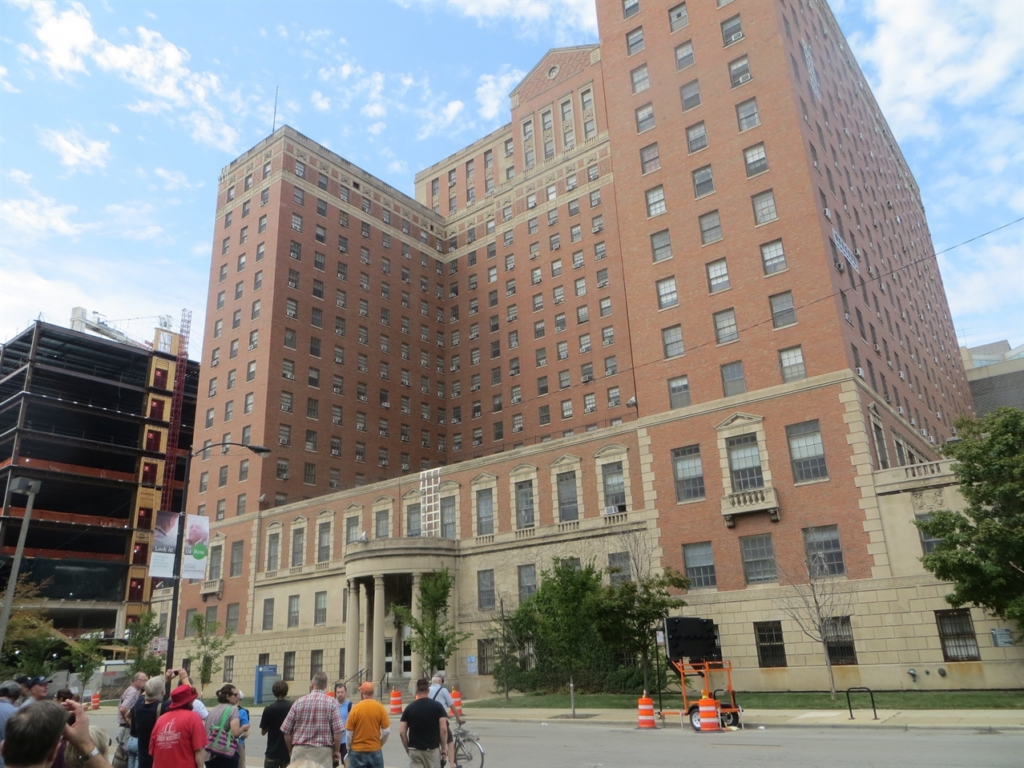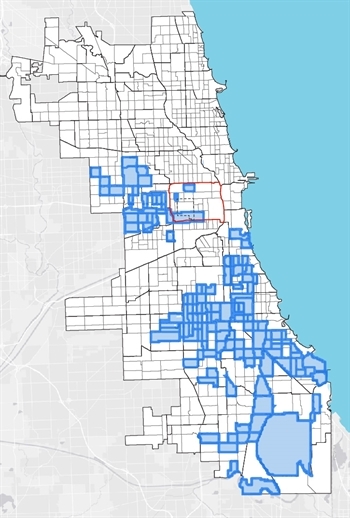How Can the City Get the Most From Its Opportunity Zones?
Here’s why a bottom-up approach to Opportunity Zone investment is essential.

The Illinois Medical District. Thousands of people commute through the area each day, the IMD is recognizable to many Chicagoans for its massive new and old medical buildings. The IMD is also home to three of Chicago’s 135 Opportunity Zones. The Metropolitan Planning Council and several partners are working together to understand how Chicago can best incentivize equitable development in Opportunity Zones across the city. The research has shown a clear need for community residents and stakeholders to be included in investment conversations to ensure that the investment actually aligns with community needs.
Earlier this year, MPC produced an investment prospectus in partnership with the Illinois Medical District (IMD), The University of Chicago Harris School of Public Policy, and Accelerator for America. The prospectus reviewed the Near West Side community and focused specifically on the Illinois Medical District (IMD) to prioritize sites in Opportunity Zones that are primed for investment. As part of this report, MPC not only focused specifically on the qualities and conditions of areas within the IMD, but also expansively on how an evaluation can be conducted for other Opportunity Zones within the City of Chicago. Broadly, the report provided a template to determine the areas that have the conditions for successful investments, as well as consider the potential impacts investments may have on surrounding residents.
To put it simply, how can Chicago communities get the most out of Opportunity Zones?

What are Opportunity Zones?
Opportunity Zones were designated by the federal Treasury Department, created to increase private investment in low-income communities by offering a tax incentive to qualified investors. The program was signed into law on December 22, 2017 as part of the Tax Cuts and Jobs Act.
The Illinois State government selected census tracts to be designated as Opportunity Zones. There are 327 Opportunity Zones designated across the state with 181 in Cook County and 135 within the City of Chicago. Selection criteria for 133 of these 135 Chicago Opportunity Zones included, but was not restricted to the following:
- Unemployment rate of 20 percent or more
- Median family income of less than $38,000, which is approximately 50 percent of Area Median Income
- Poverty rate of 30 percent or more
As shown in the adjacent map, a majority of the city’s Opportunity Zones are located across Chicago’s south and west sides.
Who do opportunity zones benefit?
Critics of Opportunity Zones have pointed to the potential for displacement and gentrification, and the lack of federal and state oversight for how zones are selected nationwide. Opportunity Zones were created using 2010 census data and areas in some cities were already in the process of economically transitioning by the time they were designated as Opportunity Zones in 2017. Investments were already happening and in these instances the tax incentives are unnecessary, which lends merit to the arguments made by critics. Opponents have also questioned whether tax breaks will truly revitalize economically distressed communities or simply serve as a tool to increase profits for property owners and investors.
Some research has shown that the latter has increasingly become the case across the country. A recently published study concludes that while Opportunity Zones may be welcomed by those directly benefiting from the program’s tax breaks, evidence shows those benefits have not extended to broadly revitalizing economically distressed communities.
How do Chicago’s Opportunity Zones compare to those of other cities?
Market research has also shown that investment in opportunity zones in Chicago lags significantly behind other metropolitan areas. Between 2018 and 2019 Chicago ranked 29th in Opportunity Zone sales totaling $952 million, dwarfed by New York and Los Angeles’ $15 billion and $12 billion respectively. This disparity is likely due to how Opportunity Zone locations were selected in the first place. The state and Chicago have taken more equitable approach to designating its Opportunity Zone focused on unemployment, median family income, and poverty rate. The selection process ensures that, for the most part, Chicago Opportunity Zones align with markers of disinvestment, but it does not entice owners and developers to invest. Lack of federal oversight and clear nationwide requirements have led to Opportunity Zones in other cities being more attractive to investors than those located in Chicago’s disinvested south and west side communities.
A look at the Illinois Medical District: The importance of community involvement
MPC’s research in creating an investment prospectus for the Near West Side, specifically focused on the Illinois Medical District (IMD) and reviewed multiple Opportunity Zones adjacent and part of the IMD from a market perspective to determine not only potential investment opportunities, but also to understand the economic forces acting on the surrounding area. This included analysis of demographic data, consumer spending, labor, employment and industry trends, new investment opportunity, and affordability and displacement considerations. Review on these measures provides a more defined understanding of which Opportunity Zones have the best potential to absorb a new investment and what the benefits of a new investment may be. The stated intentions of Opportunity Zones are to revitalize low-income communities through private market investment. The review of market factors is just the first step in beginning to determine where an investment can go to make a positive impact. That was where MPC’s work stopped and the University of Chicago Harris School of Public Policy’s work began.
A common thread throughout the market research, MPC Investment Prospectus, and the Policy Lab’s report is the lack of community involvement in the Opportunity Zone investment process, despite their position as the purported beneficiaries of the program.
In its thorough analysis of the IMD, the Policy Labs team analyzed the true economic impact of investment and development in the IMD. The team also focused on the potential for workforce development and possible partnerships between job creators in the IMD and community organizations that would enable West Side residents to connect with well-paying jobs in the life sciences. The students presented their work to a large group of stakeholders including the Chicago city clerk and other city officials, West Side Alderman, municipal finance experts, and leaders from Rush University Medical Center. A common thread throughout the market research, MPC Investment Prospectus, and the Policy Lab’s report is the lack of community involvement in the Opportunity Zone investment process, despite their position as the purported beneficiaries of the program.
Chicago has already started on the right path by locating Opportunity Zones in communities that need economic revitalization, but additional work is still needed to ensure that residents of those communities see future benefits of that revitalization. A process that acknowledges the potential benefits of Opportunity Zones are not about location alone, but that there are a number of other factors, stakeholders, and processes that must be fully understood. How can the city create a robust Opportunity Zone development bottom up process that includes community involvement and lifts up existing residents who have the most to gain.
